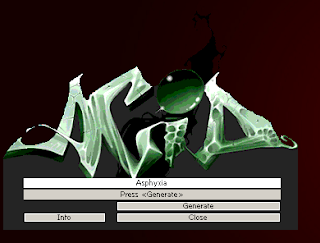January 11, 2011
Mental Alteration Recruit 2010
After a long time away trapped in a 'nop' loop (very similar to this one: for (;;) {Sleep(99999999);})
...whatever. I though that may be I wasn't actually having much fun lately and I think that it was becoz I was doing not really what I wanted to do... Fuck yeah, I think I'll do whatever I want whenever I want... Fuck the rest.
Anyways that haven't anything to do with the recruit I'm presenting ya. Which, btw, will bring you nowhere. But have fun cracking it.
Difficulty? Let's see, I guess 1/5 since I'd put moar effort and attention into the gfx than the rest... So this one hasn't anything to do with the previous recruit. [hint]In fact it has moar to do with a previous keygenme I'd done.[/hint]
I could had added a couple of things I had, in order to increase a little bit it's complexity, but... nah.
This one didn't took me too much tiem (about 2 hours for gfx'ing, and an hour for da code... another hour for testing and keygenning, divided in two days) so I guess it'll take ya liek a minute to break it...
There are a couple of memory leaks and gfx stuff to fix but I haven't any interest into solve that crap. Particullary the main dialog font is't really convincent to me... but can't find anything better... another thing is the buttons flickering when pressed. Well to be honest the whole 'image button' code has major issues... yet again I don't really care...
That's all foar now...
Asphyxia//fuuuuuuuuuuuuuuuuuuuuuuuuuuuuuuuuuuu
Example keys:
Asphyxia
41675AE245101FC192C6F4C4A0BDB6675CE43FE40A61DD79BE3D40F8E9D8F1D11CDF4593B38165F0
Mental Alteration
742F3C30792DD01EFA510D466757EE1D59F7B169968DBF2280CF35AE7D9C22D59B03BD74B96CCAF6
MAL//2010
1DA6727542AE6122E7ACEF6E3213F884413BEFAE3131ED03686606657C108C309D4C588DC015C909
Download: https://docs.google.com/leaf?id=0B0PVvUzb6s5KNWQ1ZWMzZjMtNzZkOC00M2UyLTlhZGMtYThkMTQ3NTc3Y2Zk&hl=en
...whatever. I though that may be I wasn't actually having much fun lately and I think that it was becoz I was doing not really what I wanted to do... Fuck yeah, I think I'll do whatever I want whenever I want... Fuck the rest.
Anyways that haven't anything to do with the recruit I'm presenting ya. Which, btw, will bring you nowhere. But have fun cracking it.
Difficulty? Let's see, I guess 1/5 since I'd put moar effort and attention into the gfx than the rest... So this one hasn't anything to do with the previous recruit. [hint]In fact it has moar to do with a previous keygenme I'd done.[/hint]
I could had added a couple of things I had, in order to increase a little bit it's complexity, but... nah.
This one didn't took me too much tiem (about 2 hours for gfx'ing, and an hour for da code... another hour for testing and keygenning, divided in two days) so I guess it'll take ya liek a minute to break it...
There are a couple of memory leaks and gfx stuff to fix but I haven't any interest into solve that crap. Particullary the main dialog font is't really convincent to me... but can't find anything better... another thing is the buttons flickering when pressed. Well to be honest the whole 'image button' code has major issues... yet again I don't really care...
That's all foar now...
Asphyxia//fuuuuuuuuuuuuuuuuuuuuuuuuuuuuuuuuuuu
Example keys:
Asphyxia
41675AE245101FC192C6F4C4A0BDB6675CE43FE40A61DD79BE3D40F8E9D8F1D11CDF4593B38165F0
Mental Alteration
742F3C30792DD01EFA510D466757EE1D59F7B169968DBF2280CF35AE7D9C22D59B03BD74B96CCAF6
MAL//2010
1DA6727542AE6122E7ACEF6E3213F884413BEFAE3131ED03686606657C108C309D4C588DC015C909
Download: https://docs.google.com/leaf?id=0B0PVvUzb6s5KNWQ1ZWMzZjMtNzZkOC00M2UyLTlhZGMtYThkMTQ3NTc3Y2Zk&hl=en







